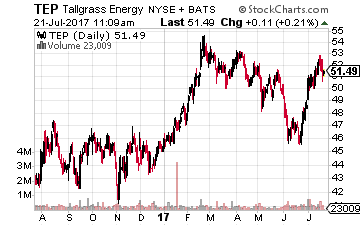Quarterly earnings release time is the real news make or break time for most publicly traded companies. For investors in many publicly traded companies, these once-every-three months information dumps are the only time actual business results can be reviewed and analyzed. All the stuff you read in the 90 days between release dates are just speculations, projections and guesses. When the actual earnings numbers come out, the market often is not kind to share prices when the earnings report or management statements include bad news or negative business projections.
If you regularly follow how a company’s business operates, it is possible to get an idea what may come out in the next earnings reports. With some companies, the economic conditions in their business sectors will provide a preview of what may happen when earnings are released. For example, energy companies are affected by changing values for crude oil, natural gas and fuels, depending on what they do in the broader energy market. With other companies the potential benefits and dangers are subtler, and unless you follow the companies very closely, you could get blindsided by a negative earnings report.
High yield shares are especially subject to falling share prices if the market reads the financial reports and decides there is potential for a dividend reduction. Nothing scares the market more than the fear of a dividend cut from a big dividend stock. Here are three high-yield stocks with significant probability of a negative earnings surprise.
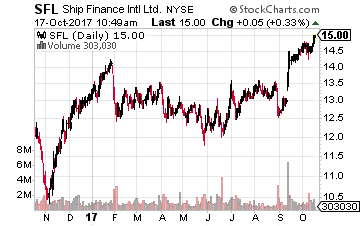 Ship Finance International (NYSE: SFL) owns a diverse fleet of commercial vessels. These ships are leased on long term contracts to shipping operators. Ship Finance gets a significant portion of its revenue from Seadrill Limited (NYSE: SDRL) which is going through a bankruptcy like reorganization. Ship Finance has worked out a new payment scheme with Seadrill, and in late August the SFL dividend was reduced by 22%. Contrary to what you would expect, after the initial price decline following the dividend announcement, the SFL share price has gained over 14%. I think the market is wrong about Ship Finance doing better after the dividend cut. I reviewed the company’s two must recent earnings reports and there are negative headwinds in several of the shipping sectors. I recommend against holding SFL shares through the earnings release in late November.
Ship Finance International (NYSE: SFL) owns a diverse fleet of commercial vessels. These ships are leased on long term contracts to shipping operators. Ship Finance gets a significant portion of its revenue from Seadrill Limited (NYSE: SDRL) which is going through a bankruptcy like reorganization. Ship Finance has worked out a new payment scheme with Seadrill, and in late August the SFL dividend was reduced by 22%. Contrary to what you would expect, after the initial price decline following the dividend announcement, the SFL share price has gained over 14%. I think the market is wrong about Ship Finance doing better after the dividend cut. I reviewed the company’s two must recent earnings reports and there are negative headwinds in several of the shipping sectors. I recommend against holding SFL shares through the earnings release in late November.
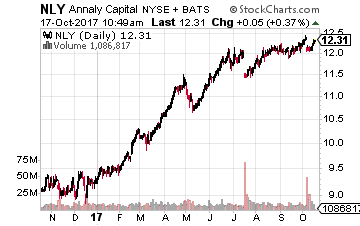 Annaly Capital Management, Inc. (NYSE: NLY) is a high-yield, agency mortgage-backed securities (MBS) owning REIT. In its 2017 first quarter earnings report the company owned $74 billion worth of agency MBS. The company owns $10 billion of other assets, including $5 billion of commercial property mortgages. This large pile of assets is held aloft by a total of $72 billion of debt. In the quarter, Annaly reported an average asset yield of 2.93% and an interest cost of 1.74% leaving a net spread of 1.19%. This spread is down from the second quarter and almost half of the 2.28% spread reported in the first quarter of 2016. Long term rates as indicated by the 10-year Treasury bond remain stubbornly in the 2.25 to 2.3% range. The Fed plans to continue to increase short term rates. Last quarter, NLY just covered the $0.30 per share dividend. If the company does not cover the dividend this quarter, the share price will fall. This company’s profits are being tightly squeezed and the next Fed rate increase is going to significantly tighten the noose.
Annaly Capital Management, Inc. (NYSE: NLY) is a high-yield, agency mortgage-backed securities (MBS) owning REIT. In its 2017 first quarter earnings report the company owned $74 billion worth of agency MBS. The company owns $10 billion of other assets, including $5 billion of commercial property mortgages. This large pile of assets is held aloft by a total of $72 billion of debt. In the quarter, Annaly reported an average asset yield of 2.93% and an interest cost of 1.74% leaving a net spread of 1.19%. This spread is down from the second quarter and almost half of the 2.28% spread reported in the first quarter of 2016. Long term rates as indicated by the 10-year Treasury bond remain stubbornly in the 2.25 to 2.3% range. The Fed plans to continue to increase short term rates. Last quarter, NLY just covered the $0.30 per share dividend. If the company does not cover the dividend this quarter, the share price will fall. This company’s profits are being tightly squeezed and the next Fed rate increase is going to significantly tighten the noose.
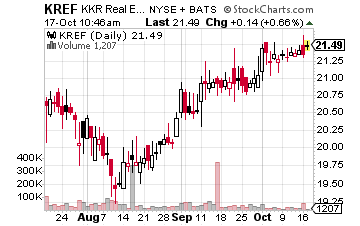 KKR Real Estate Finance Trust Inc. (NYSE: KREF) is a very new commercial mortgage REIT. The company came to market with a May 4 IPO. The shares were priced at $20.50, and now, are trading at $21.35. The company had $838 million dollars of committed capital at the end of 2016. The IPO raised another $200 million, which went into the KREF asset base. The prospectus lists a book value per share of $19.91 following the IPO. The public float after the IPO is 21.5% of the total shares. As of March 31, 2017, the company had originated $1.08 billion dollars of targeted assets. These asset types are senior real estate loans, mezzanine loans, and commercial mortgage backed securities (CMBS) “B pieces”. The third quarter earnings report will be KREF’s releasing of its first full quarter results. The danger with this stock is that it appears to be overpriced with a current 6.9% yield. Other, much larger, more established commercial mortgage REITs yield 7.9 to 8.8%. If KREF does not come out with very spectacular earnings then I expect that the market will start to price this stock like its peers, which means a 14% to 20% share price decline.
KKR Real Estate Finance Trust Inc. (NYSE: KREF) is a very new commercial mortgage REIT. The company came to market with a May 4 IPO. The shares were priced at $20.50, and now, are trading at $21.35. The company had $838 million dollars of committed capital at the end of 2016. The IPO raised another $200 million, which went into the KREF asset base. The prospectus lists a book value per share of $19.91 following the IPO. The public float after the IPO is 21.5% of the total shares. As of March 31, 2017, the company had originated $1.08 billion dollars of targeted assets. These asset types are senior real estate loans, mezzanine loans, and commercial mortgage backed securities (CMBS) “B pieces”. The third quarter earnings report will be KREF’s releasing of its first full quarter results. The danger with this stock is that it appears to be overpriced with a current 6.9% yield. Other, much larger, more established commercial mortgage REITs yield 7.9 to 8.8%. If KREF does not come out with very spectacular earnings then I expect that the market will start to price this stock like its peers, which means a 14% to 20% share price decline.
SFL, NLY, and KREF are the types of investments that I help my Dividend Hunter readers avoid. Nothing will damage your income portfolio like a high yield stock that cuts its dividend. Instead, my readers are holding onto quality high yield stocks collect the dividends every month as part of a new income system called the Monthly Dividend Paycheck Calendar. It’s currently set to pay out over $40,000 a year in extra income and has an important action date right around the corner.
Source: Investors Alley


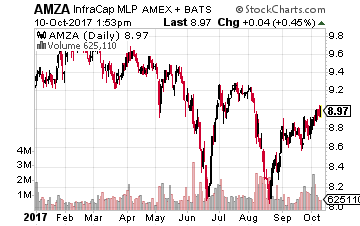 The InfraCap MLP ETF (NYSE: AMZA) sports a hard to believe 23% dividend yield. There is a range of reasons why that yield is so high, but at this point the quarterly dividends are sustainable at the current or close to the current level. If that is the case, AMZA is an investment that you can use to compound income and share count growth by over 5% every quarter.
The InfraCap MLP ETF (NYSE: AMZA) sports a hard to believe 23% dividend yield. There is a range of reasons why that yield is so high, but at this point the quarterly dividends are sustainable at the current or close to the current level. If that is the case, AMZA is an investment that you can use to compound income and share count growth by over 5% every quarter.
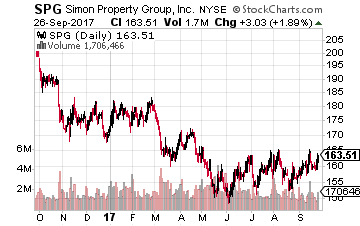 With a $50 billion market cap, Simon Property Group Inc (NYSE: SPG) is the largest publicly traded REIT. Simon owns and operates premium shopping and outlet malls. If a company needs to have retail stores, it wants to locate them in Simon run malls. The SPG dividend has been increased 15 times in the last five years, with the payout growing by 80%. This is a very successful mall operator. This stock is on sale, with a current share price down 30% from the July 2016 peak. Yield is 4.6%.
With a $50 billion market cap, Simon Property Group Inc (NYSE: SPG) is the largest publicly traded REIT. Simon owns and operates premium shopping and outlet malls. If a company needs to have retail stores, it wants to locate them in Simon run malls. The SPG dividend has been increased 15 times in the last five years, with the payout growing by 80%. This is a very successful mall operator. This stock is on sale, with a current share price down 30% from the July 2016 peak. Yield is 4.6%.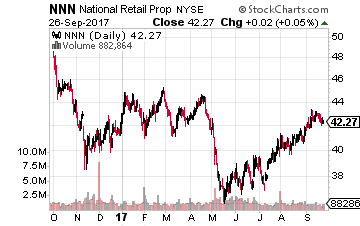 properties. The company owns over 2,500 stores, leased to 400 tenants operating in 40 different retail categories. Most of these categories are businesses which cannot be replaced by ecommerce alternatives. Business such as restaurants, health clubs, fuel and convenience stores and auto parts stores. National Retail Properties has increased its dividend for 28 Sconsecutive years. Dividend growth will be in a 3% to 5% annual range. NNN shares are down 19% since the 2016 high and yield 4.5%.
properties. The company owns over 2,500 stores, leased to 400 tenants operating in 40 different retail categories. Most of these categories are businesses which cannot be replaced by ecommerce alternatives. Business such as restaurants, health clubs, fuel and convenience stores and auto parts stores. National Retail Properties has increased its dividend for 28 Sconsecutive years. Dividend growth will be in a 3% to 5% annual range. NNN shares are down 19% since the 2016 high and yield 4.5%.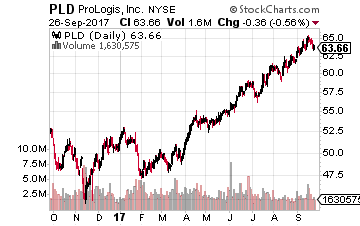 Prologis, Inc. (NYSE: PLD), with a $33 billion market cap, is a global logistics giant. The company owns or partially owns properties and development projects across 676 million square feet in 20 countries spanning four continents. Industrial/warehouse REITs are one of the hot REIT sectors. These companies can easily fill new projects and realize nice rental rate growth on existing properties. Prologis has increased its dividend by 50% over the last four years. The stock yields 3.4%.
Prologis, Inc. (NYSE: PLD), with a $33 billion market cap, is a global logistics giant. The company owns or partially owns properties and development projects across 676 million square feet in 20 countries spanning four continents. Industrial/warehouse REITs are one of the hot REIT sectors. These companies can easily fill new projects and realize nice rental rate growth on existing properties. Prologis has increased its dividend by 50% over the last four years. The stock yields 3.4%.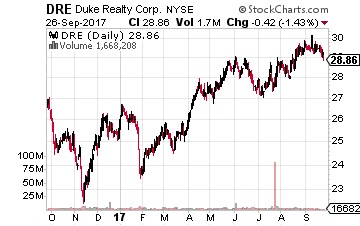 pure play, domestic only industrial REIT. The company owns 475 facilities in Tier 1 markets. Duke is highly focused on serving e-commerce sales and fulfillment. The company notes that projected e-commerce growth through 2020 will require almost 300 million square feet of additional industrial space. Amazon.com is Duke Realty’s largest tenant. The DRE dividends should grow by about 6% per year. The stock yields 2.6%.
pure play, domestic only industrial REIT. The company owns 475 facilities in Tier 1 markets. Duke is highly focused on serving e-commerce sales and fulfillment. The company notes that projected e-commerce growth through 2020 will require almost 300 million square feet of additional industrial space. Amazon.com is Duke Realty’s largest tenant. The DRE dividends should grow by about 6% per year. The stock yields 2.6%.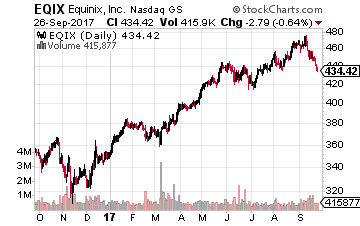 Equinix, Inc. (NASDAQ: EQIX) is a 19-year old S&P 500 company which became a REIT in 2015. Equinix owns and operates the largest global network of data centers, which focuses on connectivity and interconnection. The company’s revenues and EBITDA are growing at a high teens annual rate. AFFO (adjusted funds from operations) per share is increasing by over 20% per year. The dividend was increased by 14% this year. Equinix also has a history of paying large stock + cash special dividends. EQIX yields 1.8%.
Equinix, Inc. (NASDAQ: EQIX) is a 19-year old S&P 500 company which became a REIT in 2015. Equinix owns and operates the largest global network of data centers, which focuses on connectivity and interconnection. The company’s revenues and EBITDA are growing at a high teens annual rate. AFFO (adjusted funds from operations) per share is increasing by over 20% per year. The dividend was increased by 14% this year. Equinix also has a history of paying large stock + cash special dividends. EQIX yields 1.8%.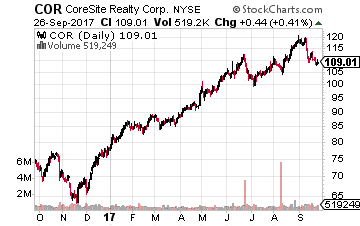 connectivity, primarily in eight major US markets. Here are the company’s amazing annual compound growth rates for the last six years.
connectivity, primarily in eight major US markets. Here are the company’s amazing annual compound growth rates for the last six years.
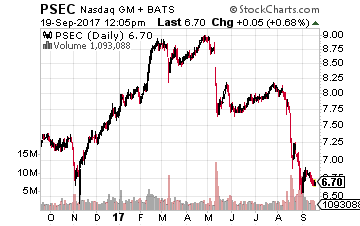
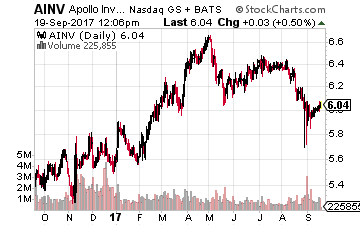 Apollo Investment Corp. (NASDAQ: AINV) is a $1.4 billion market cap BDC. The company reduced its dividend by 25% in 2016. AINV trades at a 10% discount to NAV. The current yield is 10.0% and the company’s net investment income just covered the dividend for the 2017 second quarter.
Apollo Investment Corp. (NASDAQ: AINV) is a $1.4 billion market cap BDC. The company reduced its dividend by 25% in 2016. AINV trades at a 10% discount to NAV. The current yield is 10.0% and the company’s net investment income just covered the dividend for the 2017 second quarter.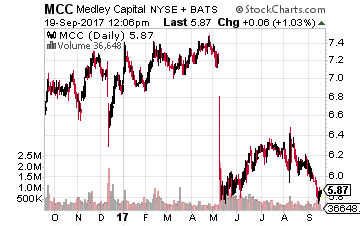

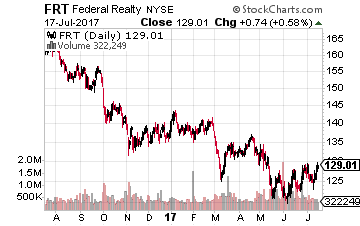 Federal Realty Investment Trust (NYSE:FRT) is a $9 billion market cap REIT that owns, operates, and redevelops high quality retail real estate in the country’s best markets. FRT has increased its dividend for 49 consecutive years, the longest growth streak of any REIT. Over the last 10 years, the average annual dividend increase has been about 5%. Last year the dividend was increased by 4.3%. Based on management guidance, an increase close to the 5% annual average is in the cards for this year. The company announces its new dividend rate in early August. The ex-dividend date will be in mid-September with payment about a week later. The FRT share price is down by 22% over the last year. This is a very high-quality REIT currently on sale. The stock yields 3.1%.
Federal Realty Investment Trust (NYSE:FRT) is a $9 billion market cap REIT that owns, operates, and redevelops high quality retail real estate in the country’s best markets. FRT has increased its dividend for 49 consecutive years, the longest growth streak of any REIT. Over the last 10 years, the average annual dividend increase has been about 5%. Last year the dividend was increased by 4.3%. Based on management guidance, an increase close to the 5% annual average is in the cards for this year. The company announces its new dividend rate in early August. The ex-dividend date will be in mid-September with payment about a week later. The FRT share price is down by 22% over the last year. This is a very high-quality REIT currently on sale. The stock yields 3.1%.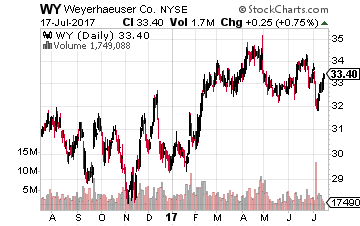 Timberlands owner and wood products producer Weyerhaeuser Co (NYSE:WY) converted to REIT status in 2010. Since then the company has more than doubled its quarterly dividend rate. However, last year, the company did not increase the dividend. Weyerhaeuser completed a merger with Plum Creek Timber in February 2016, so it’s likely that the consolidation costs kept the company from announcing a higher dividend. Business results are off to a very strong start in 2017 compared to 2016. This points to a resumption of dividend growth this year. Historically, Weyerhaeuser announces a new dividend rate in the second half of August, with payment dates in September or November. The next dividend declaration date is August 24th with the next payment dates on September 22nd and December 15th. WY yields 3.7%.
Timberlands owner and wood products producer Weyerhaeuser Co (NYSE:WY) converted to REIT status in 2010. Since then the company has more than doubled its quarterly dividend rate. However, last year, the company did not increase the dividend. Weyerhaeuser completed a merger with Plum Creek Timber in February 2016, so it’s likely that the consolidation costs kept the company from announcing a higher dividend. Business results are off to a very strong start in 2017 compared to 2016. This points to a resumption of dividend growth this year. Historically, Weyerhaeuser announces a new dividend rate in the second half of August, with payment dates in September or November. The next dividend declaration date is August 24th with the next payment dates on September 22nd and December 15th. WY yields 3.7%.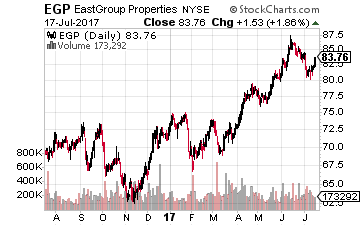 Eastgroup Properties Inc (NYSE:EGP) is a $2.8 billion market value REIT that focuses on development, acquisition and operation of industrial properties in major Sunbelt markets throughout the United States with an emphasis on the states of Florida, Texas, Arizona, California and North Carolina. The industrial properties segment is currently one of the best performing real estate sectors. The company has increased its dividend for 21 of the last 24 years, including the last five in a row. Last year the payout was increased by 3.3%. This year my forecast is for a 5% to 7% increase. The new dividend rate should be announced in late August or early September, with a mid-September ex-dividend date and end of the month payment date. EGP yields 3.0%.
Eastgroup Properties Inc (NYSE:EGP) is a $2.8 billion market value REIT that focuses on development, acquisition and operation of industrial properties in major Sunbelt markets throughout the United States with an emphasis on the states of Florida, Texas, Arizona, California and North Carolina. The industrial properties segment is currently one of the best performing real estate sectors. The company has increased its dividend for 21 of the last 24 years, including the last five in a row. Last year the payout was increased by 3.3%. This year my forecast is for a 5% to 7% increase. The new dividend rate should be announced in late August or early September, with a mid-September ex-dividend date and end of the month payment date. EGP yields 3.0%.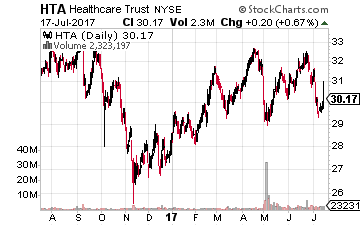 Healthcare Trust of America, Inc. (NYSE: HTA) is a $5.8 billion REIT that acquires, owns and operates medical office buildings. The company reduced its dividend in 2012 and 2013, which was followed by small increases in each of the next three years. Last year the dividend was bumped up by 1.7%, double the increase of the previous year. In 2016, the funds available for distribution per share increased by 12%, and for the 2016 first quarter, FAD per share was up 8.8% compared to a year earlier. Management has been very conservative with the dividend growth, but this year’s dividend increase may be significantly greater than the change of the past two years. Last year the new dividend rate was announced in early August, with an end of September ex-dividend date and early October payment date.
Healthcare Trust of America, Inc. (NYSE: HTA) is a $5.8 billion REIT that acquires, owns and operates medical office buildings. The company reduced its dividend in 2012 and 2013, which was followed by small increases in each of the next three years. Last year the dividend was bumped up by 1.7%, double the increase of the previous year. In 2016, the funds available for distribution per share increased by 12%, and for the 2016 first quarter, FAD per share was up 8.8% compared to a year earlier. Management has been very conservative with the dividend growth, but this year’s dividend increase may be significantly greater than the change of the past two years. Last year the new dividend rate was announced in early August, with an end of September ex-dividend date and early October payment date.
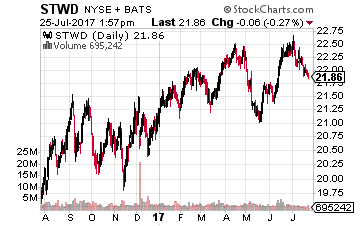
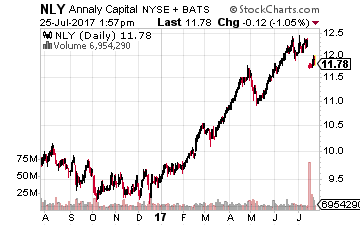 Investors familiar with the high yield residential MBS REITs may be surprised to learn that Starwood Property Trust is the third largest company by market cap in the sector. Only Annaly Capital Management, Inc. (NYSE: NLY) and AGNC Investment Corp (NASDAQ: AGNC) are valued higher than the STWD $5.7 billion market capitalization.
Investors familiar with the high yield residential MBS REITs may be surprised to learn that Starwood Property Trust is the third largest company by market cap in the sector. Only Annaly Capital Management, Inc. (NYSE: NLY) and AGNC Investment Corp (NASDAQ: AGNC) are valued higher than the STWD $5.7 billion market capitalization.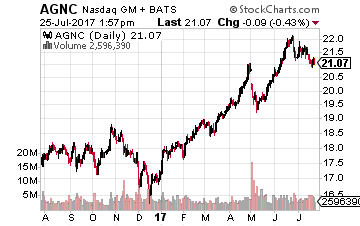 Trust is that the company is a safe and steady cash flow generator. There are no risks in the Starwood balance sheet or income statement that would give a financial writer something interesting to dig into for an article. Safe and conservative doesn’t sell in the financial news world. It sounds pretty good for an individual investment portfolio.
Trust is that the company is a safe and steady cash flow generator. There are no risks in the Starwood balance sheet or income statement that would give a financial writer something interesting to dig into for an article. Safe and conservative doesn’t sell in the financial news world. It sounds pretty good for an individual investment portfolio.
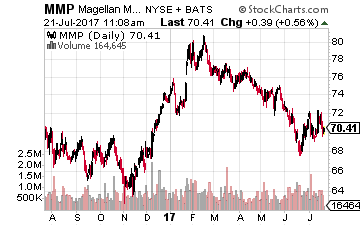 ents start to hit my e-mail inbox. I look forward to reading about how much of a pay raise my income stocks are giving me every quarter.
ents start to hit my e-mail inbox. I look forward to reading about how much of a pay raise my income stocks are giving me every quarter.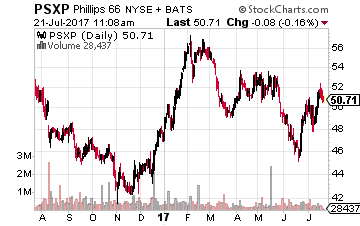 Magellan Midstream Partners, L.P. (NYSE: MMP)primarily provides refined energy products pipeline and terminal services. Magellan has now increased its distribution for 61 consecutive quarters. The new distribution is 2% higher than last quarter’s payout and up 9% compared to one year ago. MMP yields 4.95%.
Magellan Midstream Partners, L.P. (NYSE: MMP)primarily provides refined energy products pipeline and terminal services. Magellan has now increased its distribution for 61 consecutive quarters. The new distribution is 2% higher than last quarter’s payout and up 9% compared to one year ago. MMP yields 4.95%.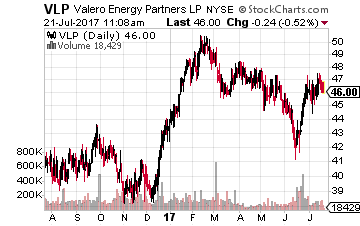 and has been increased by 21.8% over the last year. The units yield 4.5%.
and has been increased by 21.8% over the last year. The units yield 4.5%.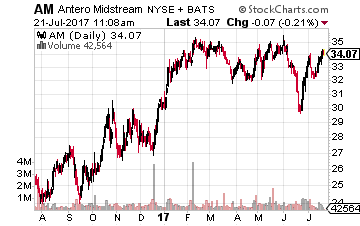 The AM distribution was just increased by 6.7% and is up 28% year-over-year. The units yield 3.7%
The AM distribution was just increased by 6.7% and is up 28% year-over-year. The units yield 3.7%